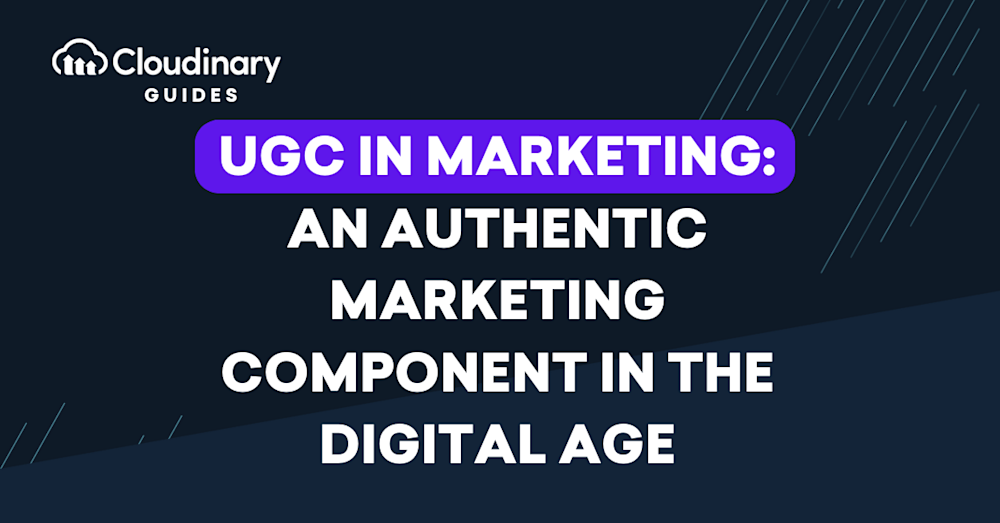What is UGC’s Role in Marketing?
The term user-generated content (UGC) refers to content—typically reviews in the form of videos, podcasts, text, images, or hashtag-marked material on social media—created by people who do not work for the brand. Unlike content generated by paid influencers, UGC originates from individuals genuinely interested in sharing their opinions on the product, service, or brand, which explains why UGC, generally considered authentic, attracts a high level of trust.
Since trust and authenticity are key elements of UGC, brands intent on leveraging it as part of their marketing strategy must retain the content’s authenticity. Also, to foster the creation of UGC, brands must, first and foremost, offer an easy process with clear instructions on the type of content they are after.
This article covers the following topics:
- How Does UGC Help Marketers and Brands?
- How Can You Capitalize on UGC to Meet Marketing Goals?
- How Do You Automate UGC for Marketing Campaigns With Cloudinary?
How Does UGC Help Marketers and Brands?
Below are the key benefits of UGC.
Create Trust and Reliability
As a rule, consumers find UGC trustworthy and reliable. In fact, 75% of the respondents to a recent study considered UGC authentic, and 80% observed that UGC humanizes marketing. Authenticity breeds trust, which leads to loyalty, resulting in more engagement and a deeper relationship among brands and consumers.
Convey Authenticity and Advocate the Brand
Why does UGC exude authenticity? Because it showcases real experiences, not promotional messages. In UGC, one learns about how people are using a product or service, how they like it, and if they have related thoughts. UGC creators are, in effect, unpaid advocates of the brand, contributing an organic kind of word-of-mouth views that are, by and large, regarded as being sincere and honest.
Present Trustworthy Opinions
UGC saves marketing organizations the cost and complexity of creating promotional content by in-house or external experts. Also gratifying yet free, UGC is truly valuable for the fresh content it offers, which often results in connections that translate into a devout follower base. Not surprisingly, a study revealed that consumers find UGC-based ads more unique, memorable, and appealing than regular ones.
Promote User Engagement and Interaction
Traditional marketing was often a one-sided communication with scant focus on user engagement. As soon as social-media ads entered the marketing funnel and stimulated comments and discussion, a significant level of engagement emerged. Now UGC is taking it up another level through congenial and staunch interactions among consumers, who unofficially yet actively participate in the brand’s marketing orbit.
How Can You Capitalize on UGC to Meet Marketing Goals?
Several techniques have proven to be effective in enabling you to leverage user-generated content for marketing.
Repost to Social Media
Many brands boost their profiles by reposting UGC on social media. Since images and videos are the most popular content shared there, platforms like Instagram and YouTube are ideal for UGC.
To ease the process of UGC campaigns, create a hashtag on social media and urge your followers to use it in their posts. In time, the hashtag would evolve into a UGC collection from which you can harvest content for sharing. Important: Be sure to secure permission before publishing UGC on your social-media profiles or other marketing channels.
Use in Advertisements
Many consumers ignore brand-initiated ads, which they largely regard as untrustworthy bait solely for the purpose of enticing them to make a purchase. As much as ads do help champion awareness and recognition, they are minimally effective in convincing consumers of the usefulness of your product or service.
In contrast, UGC can do that well, especially if you add it to your ads. For example, you can incorporate star-based or text reviews into an ad with imagery, integrate UGC videos into a YouTube ad, or add UGC audio to a podcast or radio ad.
Tell a Captivating Story With Video Content
User-generated videos can turn an already viral medium—videos—into a highly winsome campaign by offering novel and insightful perspectives on services and products, heightening the brand’s credibility, integrity, and genuineness. The result? Higher brand recognition and credibility for both existing customers and new audiences.
Inspire Creation Through Gamification
Gamification could be potent in encouraging audiences to create UGC. For example, ask them to perform one or multiple tasks and reward the participants once the tasks are complete. Make smart use of leaderboards, badges, points, high scores, and levels for a fascinating game atmosphere to enhance the game’s appeal.
It’s a good idea to tie rewards to the actions you want to promote. The rewards can take the form of unlocked badges, special discounts, or membership at a VIP club. Such prizes—as well as the game itself—promise to build long-term relationships with your audience and convert them to brand ambassadors and loyal customers.
Feature in Blogs
Adding UGC to blog posts introduces authenticity into that marketing channel. Worth incorporating are long-form reviews by bloggers and consumers, profiles on your brand, and new patrons’ feedback on your products. An efficient way of unearthing all that content is with a Google Alert, which notifies you when direct or relevant content about your brand is published. Again, be sure to seek permission from the creators before sharing their take on your blog.
How Do You Automate UGC in Marketing Campaigns With Cloudinary?
User-generated media, mainly images and videos, are a key element of engaging web and mobile experiences, hence critical for marketing campaigns. Success in creating those experiences requires a seamless and automated workflow with efficient steps for uploads, moderations, dynamic transformations, and optimized and secure delivery at scale. Fortunately, Cloudinary has you covered.
First of all, UGC uploads require clear, intuitive parameters and guidelines for users. That’s where Cloudinary’s Upload Widget and automation capabilities come in handy, enabling you to define the following:
- File Size. You can specify for user-uploaded images a maximum file size, which, if . exceeded, will be automatically reduced by Cloudinary.
- File Storage. You can leverage Cloudinary’s AI technology to automatically apply tags—item description, SKU number, campaign name, event type—to assets to facilitate discoverability.
- Derivatives. You can generate asset thumbnails, social snapshots, etc. to adjust for sizes and aspect ratios for your product listings, emails, and social-media posts.
Next, to achieve uniformity, comply with brand guidelines, and establish security for your UGC, apply similar filters or color adjustments to the assets with Cloudinary, for example:
- Fine-tune the saturation, brightness, and contrast levels.
- Stop the audio of videos so that, while they are playing, the audience can keep viewing the site content without disruption.
- Serve processed assets instead of the originals to avoid spreading malicious content.
- Moderate content with Cloudinary’s AI technology to remove inappropriate, offensive, or harmful content while meeting brand standards.
Since visuals are effective only in an ideal viewing experience, delivering high-quality and fast-loading UGC assets across devices and browsers is a must. With Cloudinary, you can automate that process:
- Serve only processed assets that are devoid of malignancies.
- Auto-format images and videos for the best display on the viewer’s browser.
- Automatically display high-resolution assets in the smallest size without sacrificing quality.
- Auto-crop images to focus on the most relevant part only.
Learn how you can enhance your UGC Marketing efforts with Cloudinary.



